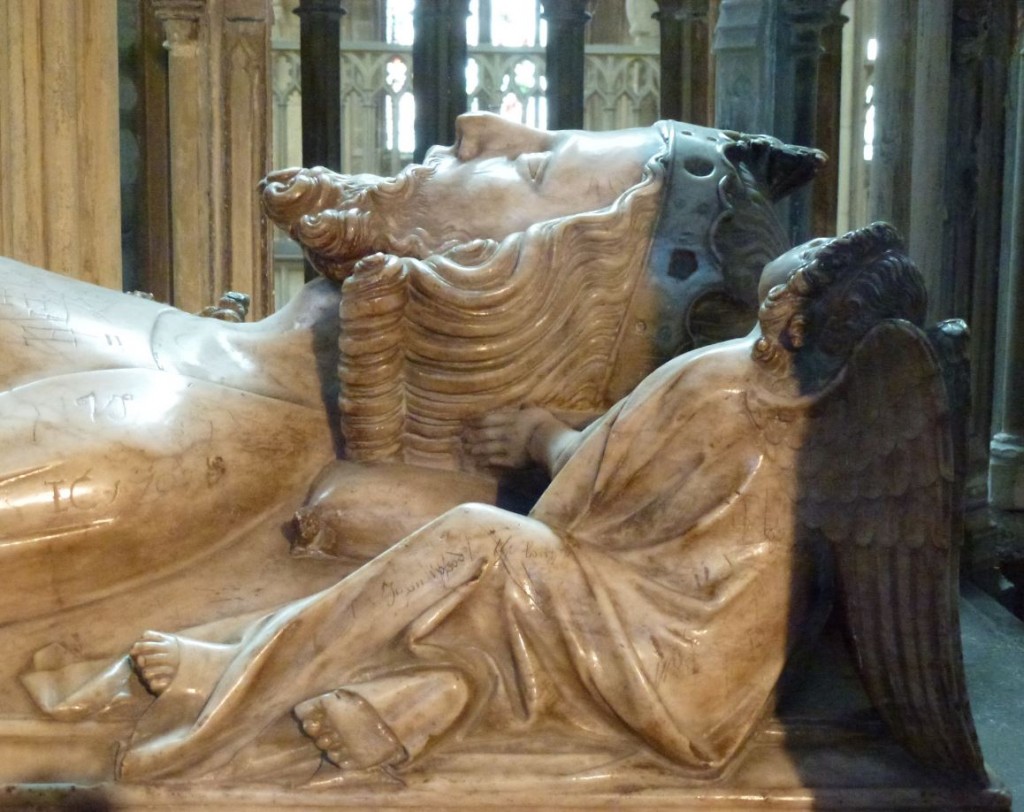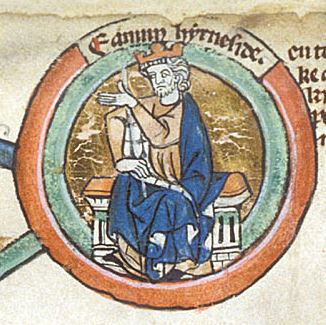On 23 September 1327, the young king Edward III received word that his father had died. The former Edward II, who had been coerced into abdication in January of that year, had been imprisoned in Berkeley Castle, Gloucestershire, at the time of his death. While official reports stated that he had died of natural causes, rumours of foul play quickly began to spread. The Lanercost Chronicle, probably composed contemporaneously, asserts cautiously that, “The deposed king died soon after, either by a natural death or by the violence of others”. It didn’t take long for chronicle accounts of Edward’s death to become both more detailed and more sensational. The story we know today, of Edward’s gruesome murder by anal penetration with a red-hot spit (the word “poker” isn’t used in any medieval or early modern text) originates in the “long version” of the Anglo-Norman Brut, composed shortly after 1333. By the sixteenth century this had become the historiographical consensus.

Today, it’s frequently assumed that this story originated as a symbolic punishment for Edward II’s perceived sexual behaviour in life. As Katherine Harvey explored in a recent NOTCHES post, Edward’s close relationships with his male favourites – first Piers Gaveston, then the two Hugh Despensers – were the subject of anxiety during his lifetime and further condemnatory speculation after his death. Chroniclers began to associate Edward’s reign with transgressive sexual behaviour or “lechery”, while hinting that this resulted from his closeness to his favourites; by the sixteenth century, a consensus was emerging that those relationships were both romantic and sexual. So it’s easy to understand why the “red hot spit” story has been interpreted as retribution for Edward’s participation in anal sex with other men. But was this sexually mimetic aspect the sole reason behind the creation of the story?
Many historians (notably Ian Mortimer) have downplayed the murder’s sexual significations, noting instead its similarity to stories of the death of the Anglo-Saxon king Edmund Ironside. According to Henry of Huntingdon and others, Edmund was staying at the house of the treacherous duke Edric, when he got up in the night “to do the duty of nature”. Edric’s son, hiding in the pit beneath the toilet seat, “pierced the king among his private parts twice with a sharp dagger” and left him for dead.
Though this story might sound superficially similar to Edward II’s “red hot spit” murder, there are a number of crucial differences. Accounts of Edmund Ironside’s death are impersonal, making no mention of his pain or distress; by contrast, the Brut notes that Edward II “was wonder sore afraid to be dead there and slain”. Later accounts (following the sympathetic Chronicon of Geoffrey le Baker) state that Edward’s cry of pain was heard for miles around. Where accounts of Edward II’s death devote most space to the logistics of the murder method, stories of Edmund Ironside focus on identifying his death as treason, and detailing the punishment of his murderers for treachery. For a hardy warrior king like Ironside to be traitorously murdered in a compromising position is unfair and self-consciously bathetic: it’s a story written to outrage its readers.

We should also question how similar the two murder methods really are. Edmund Ironside’s body is not described – without assertions to the contrary, we have to assume that an anal spear-wound would have been pretty messy. Conversely, stories of Edward II’s murder go to great lengths to describe its invisible nature. The Brut takes pains to point out that the red-hot spit was inserted through a horn, so that no marks were left on the skin: “and so they quelled their lord, [so] that no thing was perceived”. This detail is remarkably consistent in later retellings. Very few texts narrate the “red hot spit” murder story without also specifying that it was inserted through a horn so as to conceal the murder.
Does this rule out the possibility that the story of Edmund Ironside’s murder provided any inspiration for the “red hot spit” story that was told about Edward II? Not necessarily. One thing the two stories do share is sensation: they’re exciting, lurid anecdotes crafted with readers in mind. Julia Marvin has argued convincingly that the Brut’s writer made many decisions for creative, literary reasons, something that almost certainly influenced the enormous popularity of the narrative. The Brut writer would have come across two competing stories about Edmund Ironside in his sources, and chose to use the alternative version – in which Edmund is killed by a mechanical statue of an archer – in his narrative, leaving the anally penetrative story as a “spare” that may have seemed too good to waste completely.

But the differences between the two stories make it clear that no simple transference took place. The Brut writer may have chosen to imitate the sensational nature of Edmund Ironside’s murder when writing about Edward II, but he also needed an invisible murder method that could have been plausibly misinterpreted as natural causes. He needed a painful, torturous murder that would introduce an element of sympathy for the former king, something later exploited by the partisan account of Geoffrey Le Baker. And among these other factors, there is an element of sexual mimesis – whereby the penetrative murder method could be seen to mimic, and perhaps punish, the victim’s habitual sexual behaviour – that isn’t present in the story of Edmund Ironside. The Brut, as mentioned above, is one of the earliest texts to accuse Edward II of “lechery”, and when it comes to his murder, there is a suggestion that he is complicit in his own anal penetration. Awakening to find his captors are trying to smother him with a table, Edward “turned his body then upside down”, effectively allowing the insertion of the red-hot spit. The story could, therefore, be read as Edward inviting his own penetrative murder just as he invited anal sex during his life – and thus as implying that his sinful sexual practises constituted an effective “invitation” to retributive murder.
While the objective truth of Edward II’s sexual behaviour is inevitably resistant to scholarly investigation, his historiographical reputation undeniably emphasises the closeness of his relationships with his male favourites. Combined with – and perhaps influencing – the acceptance of the “red hot spit” story, this focus on sexual transgression has led to an over-emphasis on the sexually mimetic aspect of his murder. This is a valid potential reading, but it isn’t the story’s only signification: in most texts that follow the Brut the element of Edward’s complicity is missing, and his dying screams of pain become the account’s most significant aspect. If we approach accounts of Edward’s murder with the expectation that the “red hot spit” method was invented as a symbolic punishment for anal sex, we obscure our interpretive capacity at the outset, blinding ourselves to other possibilities. At the same time, to assume that the story of Edward’s murder was straightforwardly influenced by that of Edmund Ironside is equally simplistic. Accounts of Ironside’s murder, though probably influential, don’t provide an exact analogue: they show the traitorous murder of a brave warrior, not the torturous dispatch of a helpless prisoner. If we’re to comprehend how Edward II’s contemporaries understood his sexual behaviour, we need to stop assuming that we know what the story of the “red hot poker” – or indeed spit – really means.
 Kit Heyam is a PhD candidate at the University of Leeds, working on a thesis entitled “Literary and historical representations of Edward II and his favourites, c.1305-1700”. Their research interests centre on the textual expression and negotiation of anxiety surrounding sexual transgression in medieval and early modern texts, particularly (though not exclusively) love and sex between men. They are also an assistant coordinator of York LGBT History Month, and will be coordinating York’s first LGBT history school outreach programme later in the year. They blog sporadically at Unbeseeming Words, and tweet from @krheyam.
Kit Heyam is a PhD candidate at the University of Leeds, working on a thesis entitled “Literary and historical representations of Edward II and his favourites, c.1305-1700”. Their research interests centre on the textual expression and negotiation of anxiety surrounding sexual transgression in medieval and early modern texts, particularly (though not exclusively) love and sex between men. They are also an assistant coordinator of York LGBT History Month, and will be coordinating York’s first LGBT history school outreach programme later in the year. They blog sporadically at Unbeseeming Words, and tweet from @krheyam.

NOTCHES: (re)marks on the history of sexuality is licensed under a Creative Commons Attribution-NonCommercial-NoDerivatives 4.0 International License.
Based on a work at www.notchesblog.com.
For permission to publish any NOTCHES post in whole or in part please contact the editors at NotchesBlog@gmail.com





Thank you, Kit, for a smart and thoughtful reading about how violence is remembered and retrospectively sexualized. There are interesting connections between this piece and Tom Foster’s recent blog post, Sex and the American Quest for a Relatable Past: http://notchesblog.com/2015/03/14/sex-and-the-american-quest-for-a-relatable-past/. Foster writes, “how we remember the sex lives of the founding fathers reflects contemporary concerns and projections.” Foster’s ideas apply to this piece too: By tracing how stories about Edward II, his sexuality and his violent death have changed over time, we’re able to see that the stories are more about the subsequent tellers and their societies than about Edward and his demise.
Thanks so much! That’s really true, I think: as historians of sexuality we’re constantly forced to negotiate the attitudes towards and conceptions of sex that inflect the second-hand stories we study, as well as those experienced by the characters in those stories. And since sex is a particularly potent signifier of so many other things – I really enjoyed Foster’s analysis of its perceived relation to morality among other issues – it becomes particularly important to consider how it’s used and represented in subsequent accounts.
Great scholarship on this. Isn’t it frustrating when the final truths become unavailable–or maybe a little mystery isn’t a bad thing.
Thank you! 🙂 I guess it is frustrating on some levels – though (as Gillian’s comment gestured towards too) you could argue that when someone’s story is told and retold over centuries, the fiction becomes the history. So in some ways, the historiographical consensus about Edward II (like the penetrative murder) becomes more significant – and more interesting – than the objective truth. That’s not to say I wouldn’t love an insight into his mind, of course!
Pingback: New and Noteworthy: What We’re Reading |
If you haven’t read any of Kathryn Warner’s excellent Edward II blog, you might want to check it out. She has several entries about Edward’s putative death, and the development of the hot-poker story. I will include the URL for the likely most relevant one here, but there are others.
http://edwardthesecond.blogspot.com/2006/09/edward-iis-death-part-one.html
Thank you! 🙂 yes, I really enjoy Kathryn’s blog – some amazingly meticulous research! As you’ll see from my post I’m more cautious about accepting her argument that the penetrative murder story “is nothing more than a reflection of the popular belief that Edward was the passive partner in sexual acts with men” – I’m interested in trying to establish the extent to which that was a popular belief at different points in history/in different contexts – but I definitely agree with her assessment of the story’s historical validity.
Pingback: Seeing Sodomy: An Interview with Robert Mills | NOTCHES